Assessment of Metal Flow Balance in Multi-Output Porthole Hot Extrusion of AA6060 Thin-Walled Profile
Abstract
:1. Introduction
2. Design Scheme of Multi-Output Porthole Extrusion Die
2.1. General Description of the Extruded Profile
2.2. The Main Structure Design of the Multi-Output Porthole Extrusion Die
2.3. Design of Experiment by Means of the Taguchi Method
3. Thermo-Mechanical Modelling
3.1. Basic Theories of Numerical Algorithm and Material Model
3.2. Process Modelling
4. Results and Discussions
4.1. The Sources of Unbalanced Deformation
4.2. Analysis of Variance
4.3. Experimental Validation
5. Conclusions
- (1)
- The main structure design of the multi-output porthole extrusion die includes some novel features such as a circular pattern of the portholes with a dart-shape inlet bridge, a buckle angle in the inlet side of the upper die, a two-step welding chamber, and a non-uniform bearing length distribution. The presented die scheme is helpful to get a balance metal flow and reduce the forming load.
- (2)
- Four die structure parameters: The billet buckle angle, the porthole bevel angle, the depth of welding chamber, and the bridge type were optimized by the Taguchi method and optical simulation. Their optimum values are 30° of the billet buckle angle, 7.5° of the porthole bevel angle, 15 mm of the depth of first welding chamber, and the trapezium shape of bridge types, respectively.
- (3)
- The billet buckle angle α in the upper die should have a considerable effect on the metal flow in the beginning of the extrusion process rather than the metal flow control in the porthole stage. The porthole bevel angle β has significant effects on the mandrel deflection and the relative exit velocity in the multi-output porthole extrusion. The increase of the porthole bevel angle β decreases the mandrel deflection. The depth of first welding chamber d and the bridge type seem to have effects that may not be obvious on the metal flow during the multi-output porthole extrusion
- (4)
- In order to explore the sources of unbalanced deformations of aluminum alloy profile, two control strategies based on the simulation model, i.e., the optimal bearing length and the mandrel deflection compensation, are proposed to obtain a better metal flow and thin-walled aluminum alloy extruded profile.
- (5)
- The results of experimental validation show that the maximum wall thickness deviation has only 0.012 mm for the profile with a 0.7 mm of main wall thickness, and the force deviation between the predicted result and the experimental one is about 6.93%. This is a relative high prediction accuracy and acceptable for an industrial extrusion case with a complex section.
Author Contributions
Funding
Acknowledgments
Conflicts of Interest
References
- Berndt, N.; Frint, P.; Wagner, M.F.-X. Influence of Extrusion Temperature on the Aging Behavior and Mechanical Properties of an AA6060 Aluminum Alloy. Metals 2018, 8, 51. [Google Scholar] [CrossRef]
- Pan, J.Y.; Xue, X. Numerical investigation of an arc inlet structure extrusion die for large hollow sections. Int. Mater. Form. 2018, 11, 405–416. [Google Scholar] [CrossRef]
- Fan, X.; Chen, L.; Chen, G.; Zhao, G.; Zhang, C. Joining of 1060/6063 aluminum alloys based on porthole die extrusion process. J. Mater. Process. Technol. 2017, 250, 65–72. [Google Scholar] [CrossRef]
- Gagliardi, F.; Ambrogio, G.; Filice, L. On the die design in AA6082 porthole extrusion. CIRP Ann. Manuf. Technol. 2012, 61, 231–234. [Google Scholar] [CrossRef]
- Lof, J.; Blokhuis, Y. FEM simulations of the extrusion of complex thin-walled aluminum sections. J. Mater. Process. Technol. 2002, 122, 344–354. [Google Scholar] [CrossRef]
- Fang, G.; Zhou, J.; Duszczyk, J. FEM simulation of aluminum extrusion through two-hole multi-step pocket dies. J. Mater. Process. Technol. 2009, 209, 1891–1900. [Google Scholar] [CrossRef]
- Sinha, M.K.; Deb, S.; Das, R.; Dixit, U.S. Theoretical and experimental investigations on multi-hole extrusion process. Mater. Des. 2009, 30, 2386–2392. [Google Scholar] [CrossRef]
- Sinha, M.K.; Deb, S.; Dixit, U.S. Design of a multi-hole extrusion process. Mater. Des. 2009, 30, 330–334. [Google Scholar] [CrossRef]
- Zhang, C.; Zhao, G.; Chen, H.; Guan, Y.; Kou, F. Numerical simulation and metal flow analysis of hot extrusion process for a complex hollow aluminum profile. Int. J. Adv. Manuf. Technol. 2012, 60, 101–110. [Google Scholar] [CrossRef]
- Sun, Z.C.; Cao, J.; Wu, H.L.; Yin, Z.K. Inhomogeneous deformation law in forming of multi-cavity parts under complex loading path. J. Mater. Process. Technol. 2018, 254, 179–192. [Google Scholar] [CrossRef]
- Lee, J.M.; Kim, B.M.; Kang, C.G. Effects of chamber shapes of porthole die on elastic deformation and extrusion process in condenser tube extrusion. Mater. Des. 2005, 26, 327–336. [Google Scholar] [CrossRef]
- Zhang, C.; Zhao, G.; Chen, H.; Guan, Y.; Cai, H.; Gao, B. Investigation on Effects of Die Orifice Layout on Three-Hole Porthole Extrusion of Aluminum Alloy 6063 Tubes. J. Mater. Eng. Perform. 2013, 22, 1223–1232. [Google Scholar] [CrossRef]
- Gagliardi, F.; Ciancio, C.; Ambrogio, G. Optimization of porthole die extrusion by Grey-Taguchi relational analysis. Int. J. Adv. Manuf. Technol. 2018, 94, 719–728. [Google Scholar] [CrossRef]
- Bakker, A.J.D.; Werkhoven, R.J.; Sillekens, W.H.; Katgerman, L. The origin of weld seam defects related to metal flow in the hotextrusion of aluminum alloys EN AW-6060 and EN AW-6082. J. Mater. Process. Technol. 2014, 214, 2349–2358. [Google Scholar] [CrossRef]
- Bakker, A.J.D.; Katgerman, L.; Zwaag, V.D.S. Analysis of the structure and resulting mechanical properties of aluminum extrusions containing a charge weld interface. J. Mater. Process. Technol. 2016, 229, 9–21. [Google Scholar] [CrossRef]
- Zhang, C.; Dong, Y.; Wang, C.; Zhao, G.; Chen, L.; Sun, W. Evolution of transverse weld during porthole extrusion of AA7N01 hollow profile. J. Mater. Process. Technol. 2017, 248, 103–114. [Google Scholar] [CrossRef]
- Yu, J.; Zhao, G.; Cui, W.; Zhang, C.; Chen, L. Microstructural evolution and mechanical properties of welding seams in aluminum alloy profiles extruded by a porthole die under different billet heating temperatures and extrusion speeds. J. Mater. Process. Technol. 2017, 247, 214–222. [Google Scholar] [CrossRef]
- Gamberoni, A.; Donati, L.; Reggiani, B.; Haase, M.; Tomesani, L.; Tekkaya, A.E. Industrial Benchmark 2015: Process monitoring and analysis of hollow EN AW-6063 extruded profile. Mater. Today Proc. 2015, 2, 4714–4725. [Google Scholar] [CrossRef]
- Selvaggio, A.; Kloppenborg, T.; Schwane, M.; Hölker, R.; Jäger, A.; Donati, L.; Tomesani, L.; Tekkaya, A.E. Extrusion benchmark 2013—Experimental analysis of mandrel deflection, local temperature and pressure in extrusion dies. Key Eng. Mater. 2013, 585, 13–22. [Google Scholar] [CrossRef]
- Selvaggio, A.; Donati, L.; Reggiani, B.; Haase, M.; Dahnke, C.; Schwane, M.; Tomesani, L.; Tekkaya, A.E. Scientific Benchmark 2015: Effect of choking and bearing length on metal flow balancing in extrusion dies. Mater. Today Proc. 2015, 2, 4704–4713. [Google Scholar] [CrossRef]
- Chen, P.C.; Chen, Y.C.; Pan, C.W.; Li, K.M. Parameter Optimization of Micromilling Brass Mold Inserts for Microchannels with Taguchi Method. Int. J. Precis. Eng. Manuf. 2015, 16, 647–651. [Google Scholar] [CrossRef]
- Maheedhara, R.G.; Diwakar, R.V.; Satheesh, K.B. Experimental Investigation on radial ball bearing parameters ssing Taguchi Method. J. Appl. Comput. Mech. 2018, 6, 69–74. [Google Scholar]
- Esat, V.; Darendeliler, H.; Gokler, M.I. Finite element analysis of springback in bending of aluminum sheets. Mater. Des. 2002, 23, 223–229. [Google Scholar] [CrossRef]
- Cai, M.; Field, D.P.; Lorimer, G.W. A systematic comparison of static and dunamic aging of two Al-Mg-Si alloys. Mater. Sci. Eng. A 2004, 373, 64–71. [Google Scholar] [CrossRef]
- Altair Hyperworks, Material Database. Altair Engineering, Inc., 2018. Available online: https://altairhyperworks.com/ (accessed on 15 June 2018).
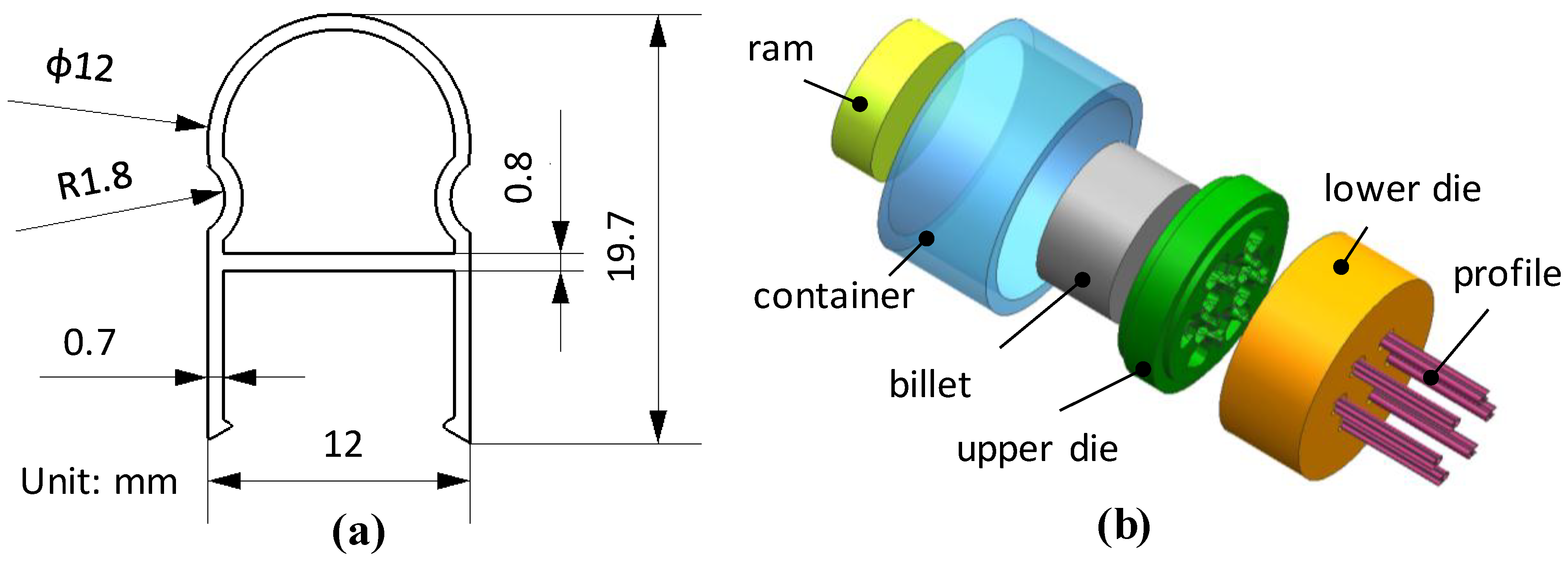
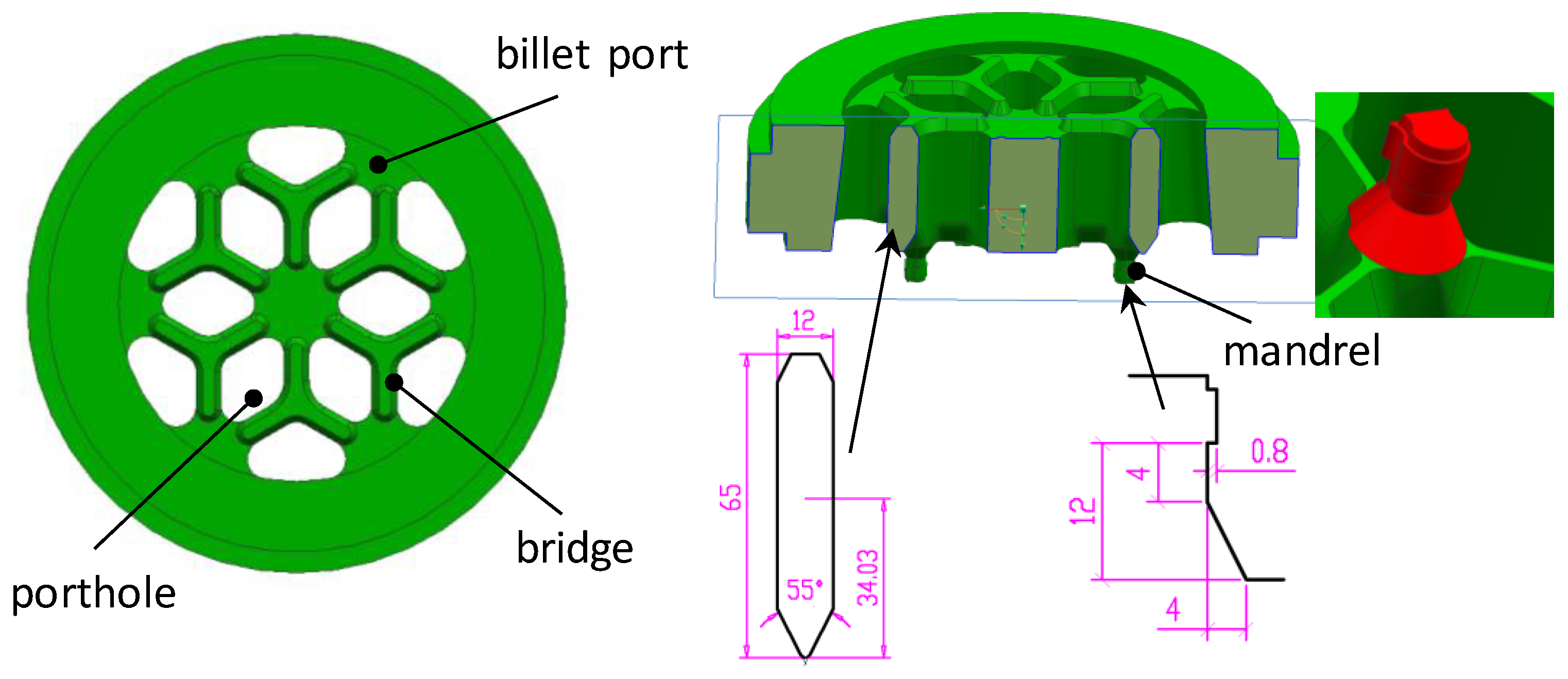

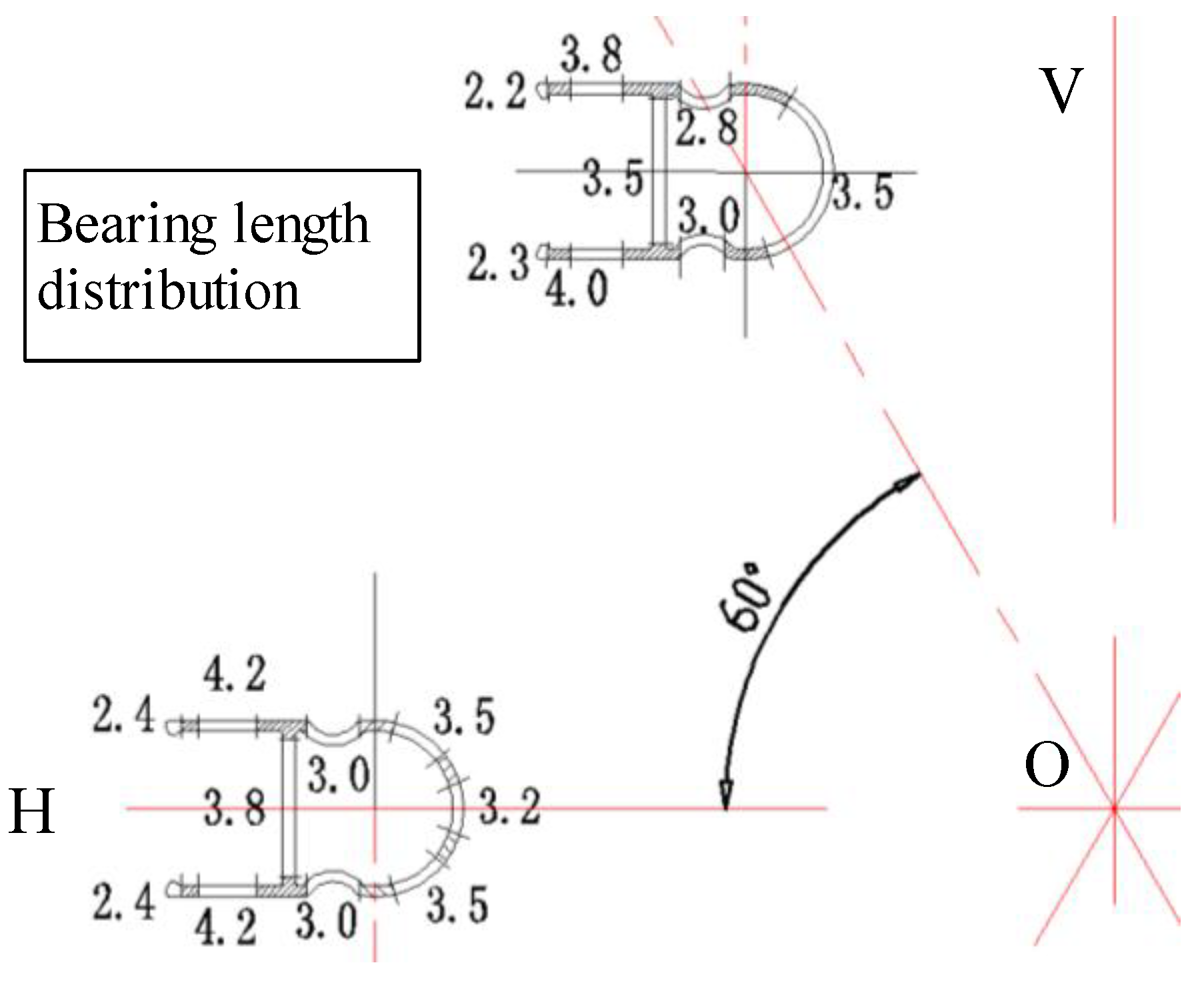
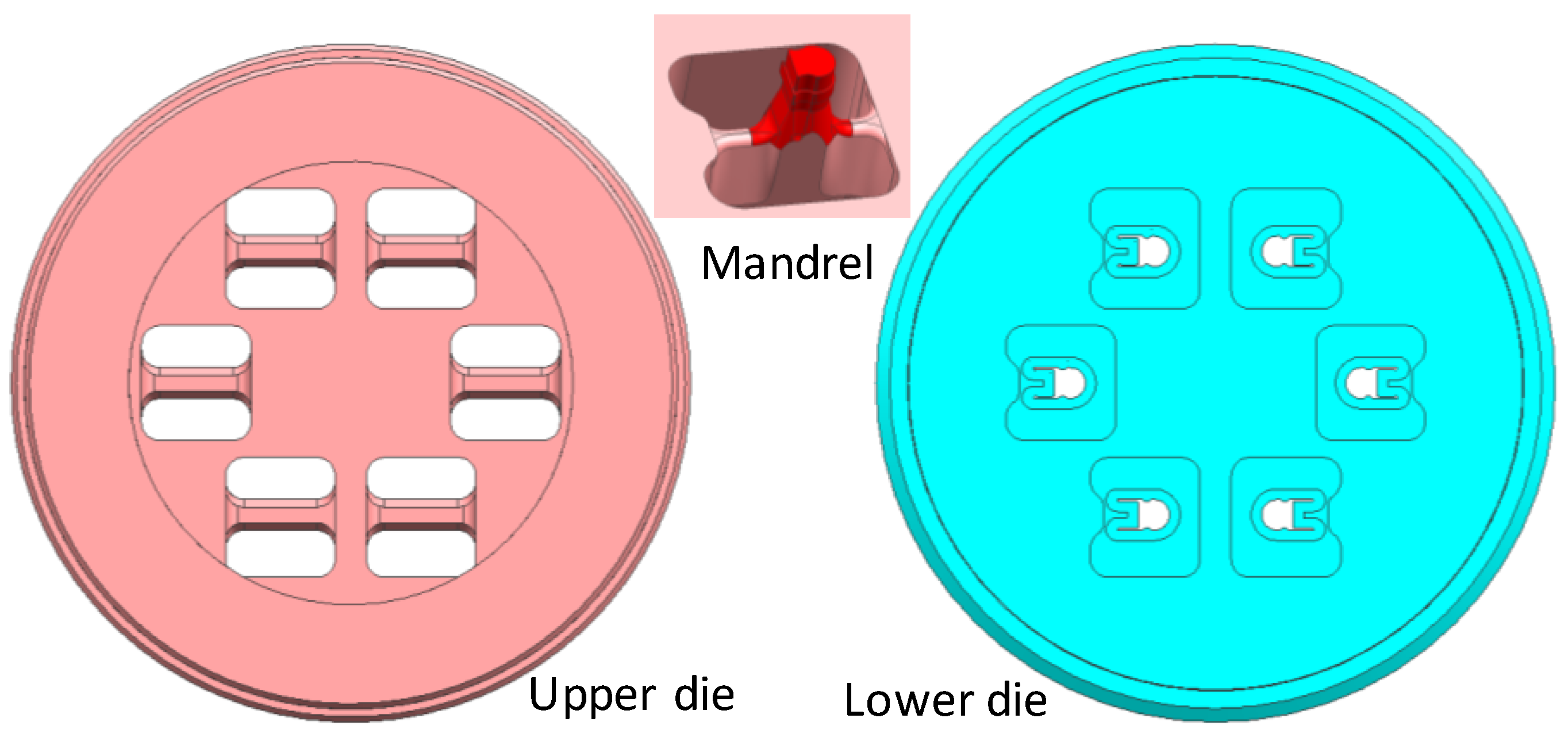
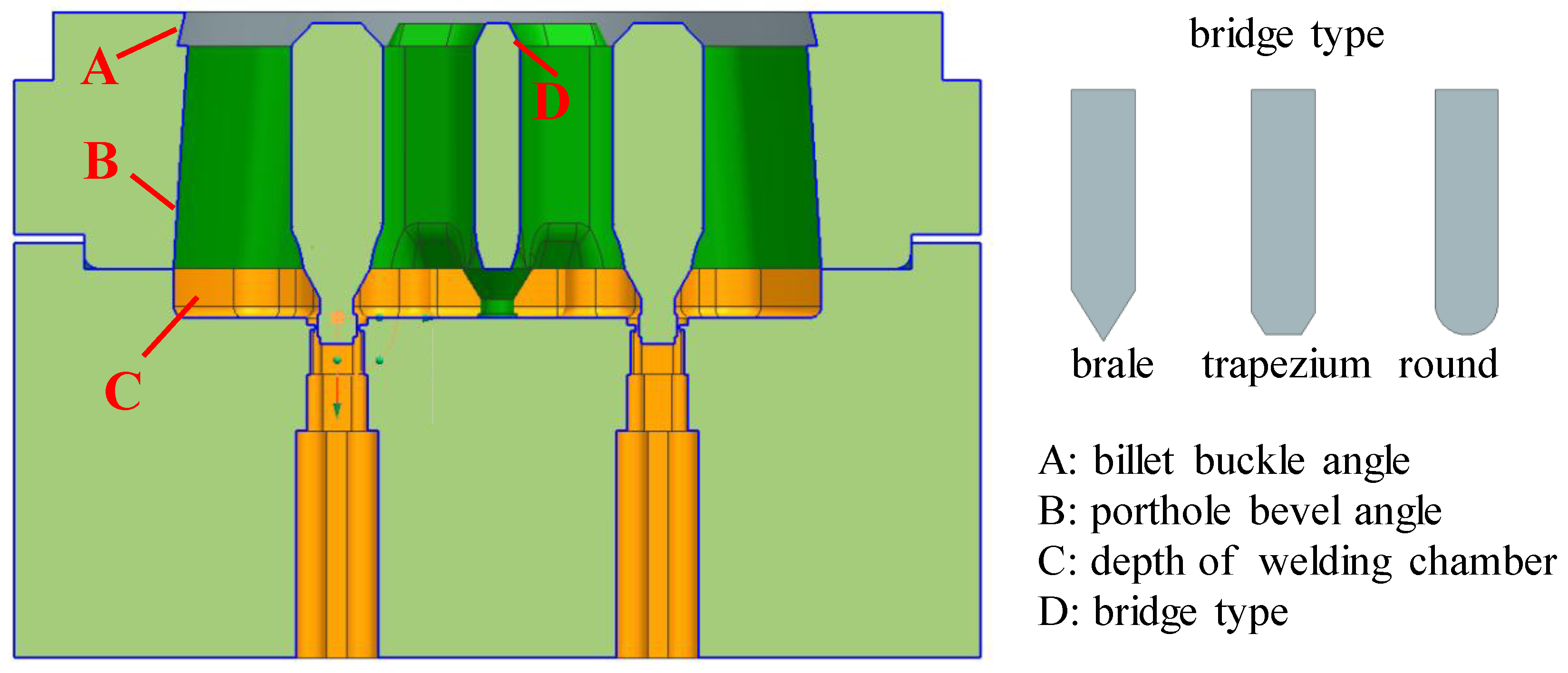
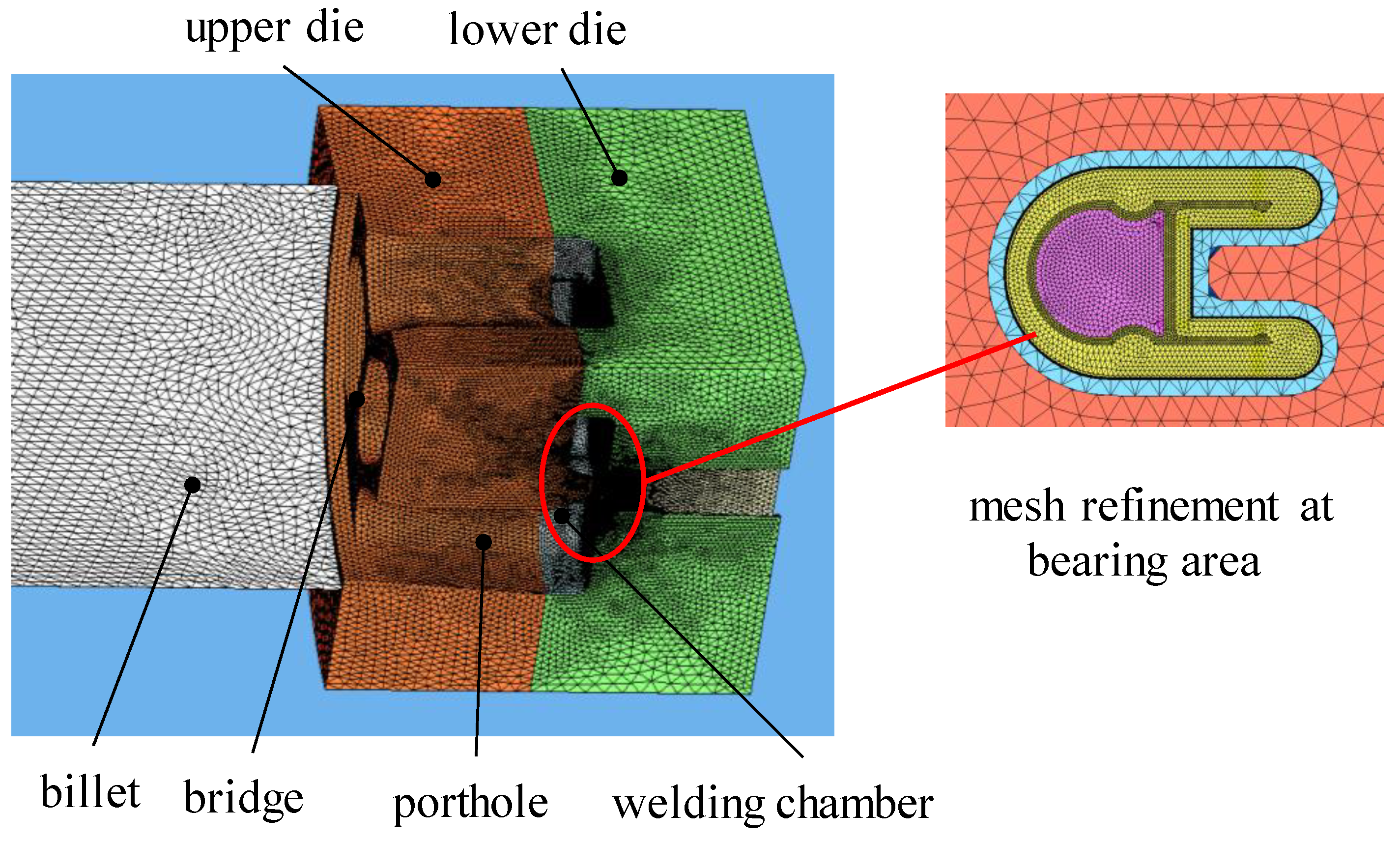

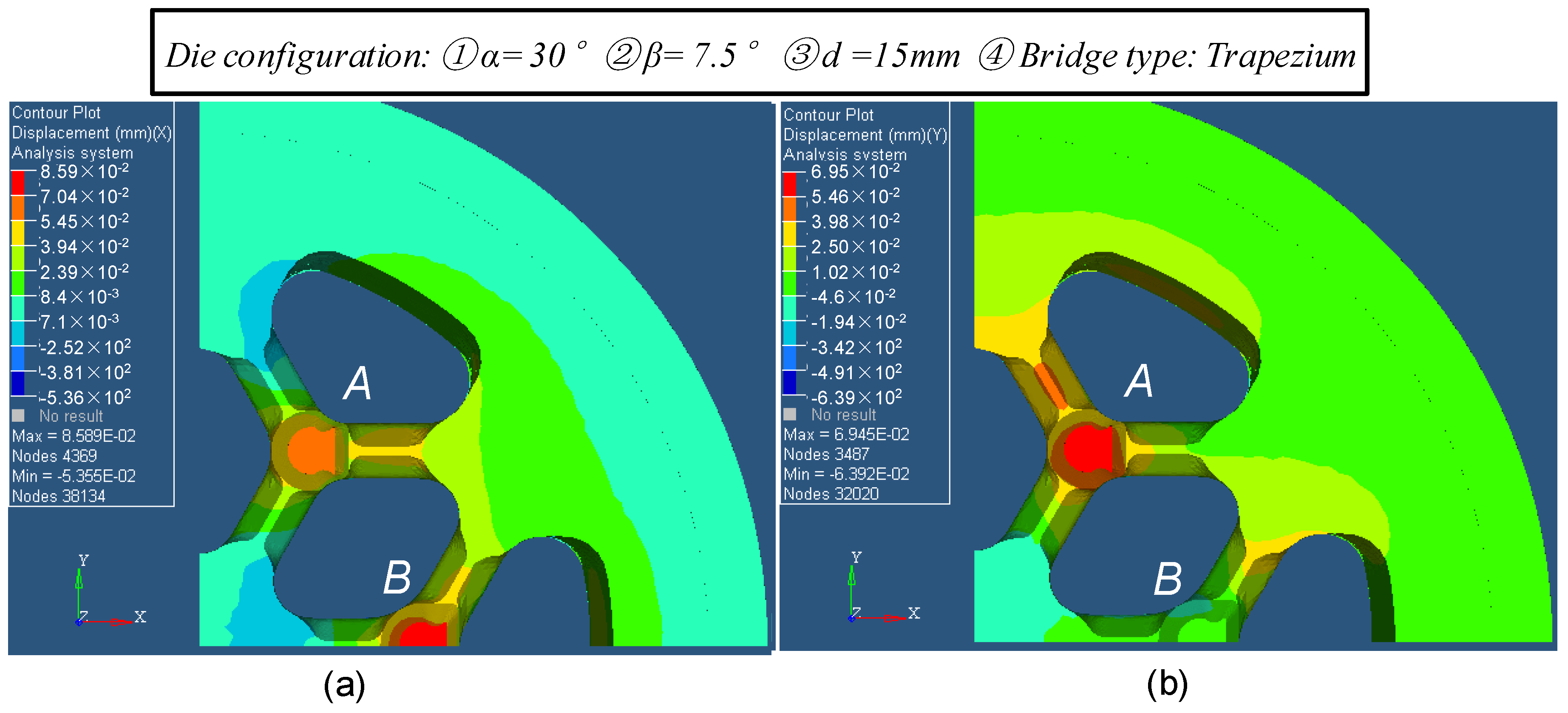
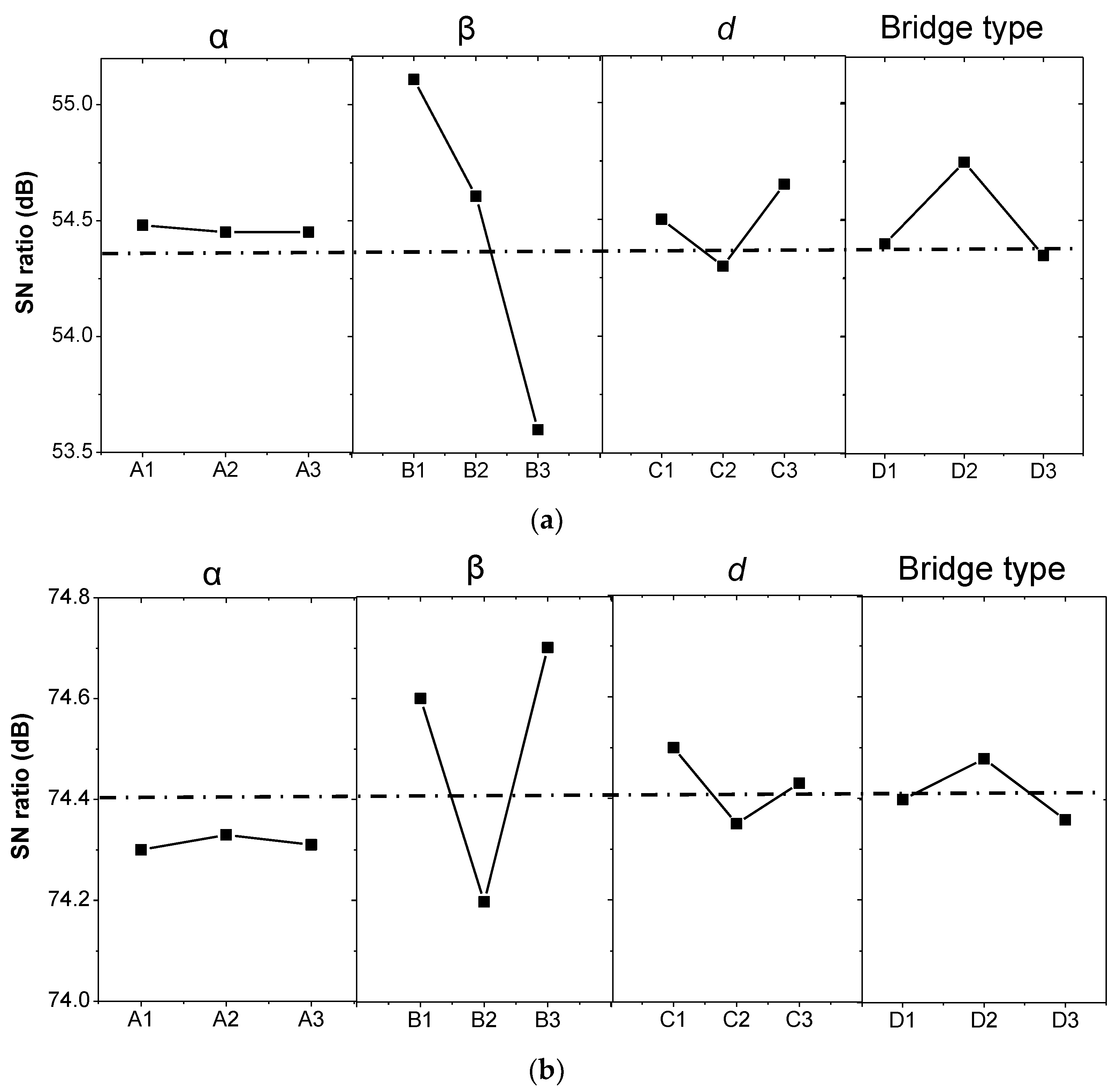
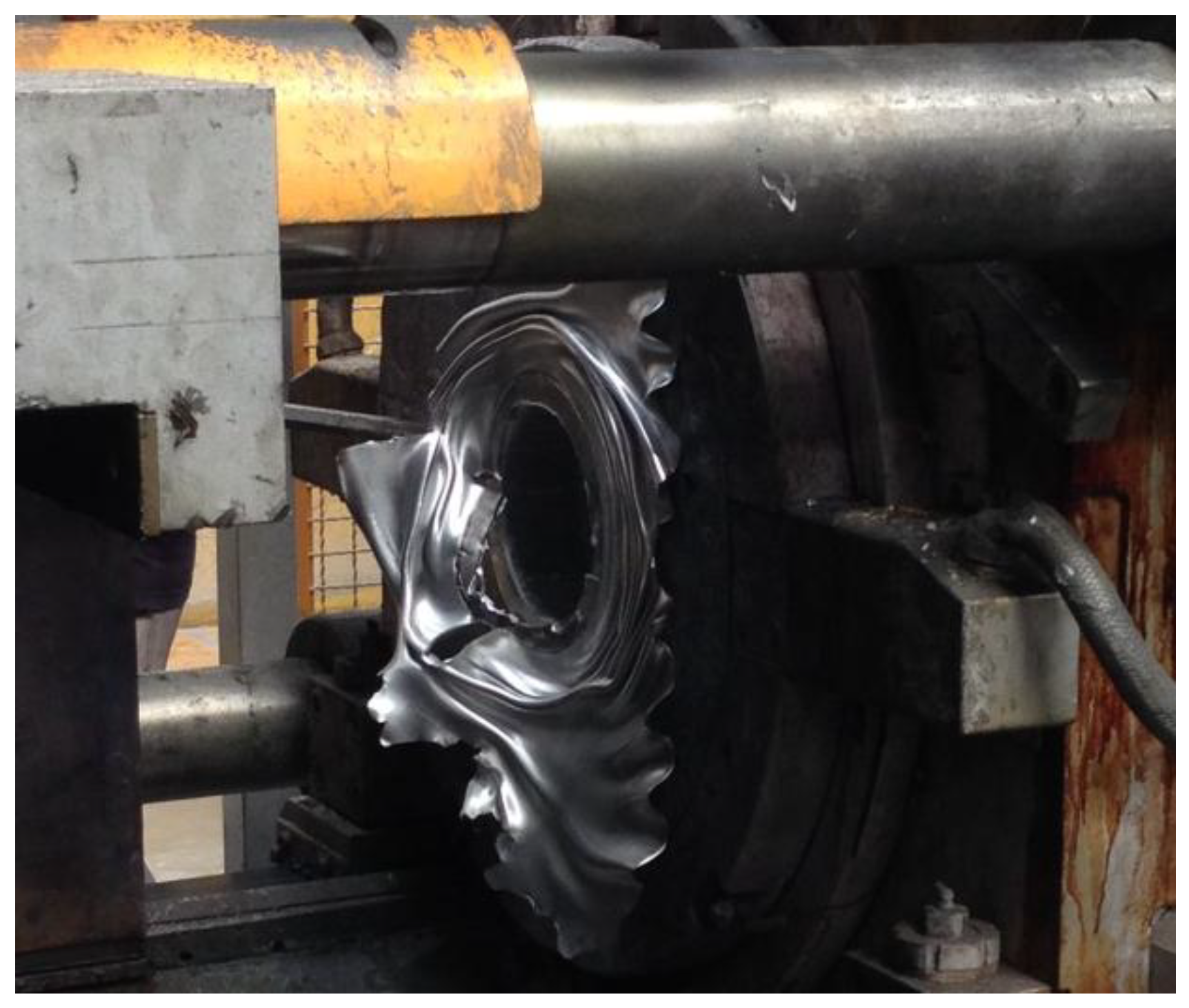
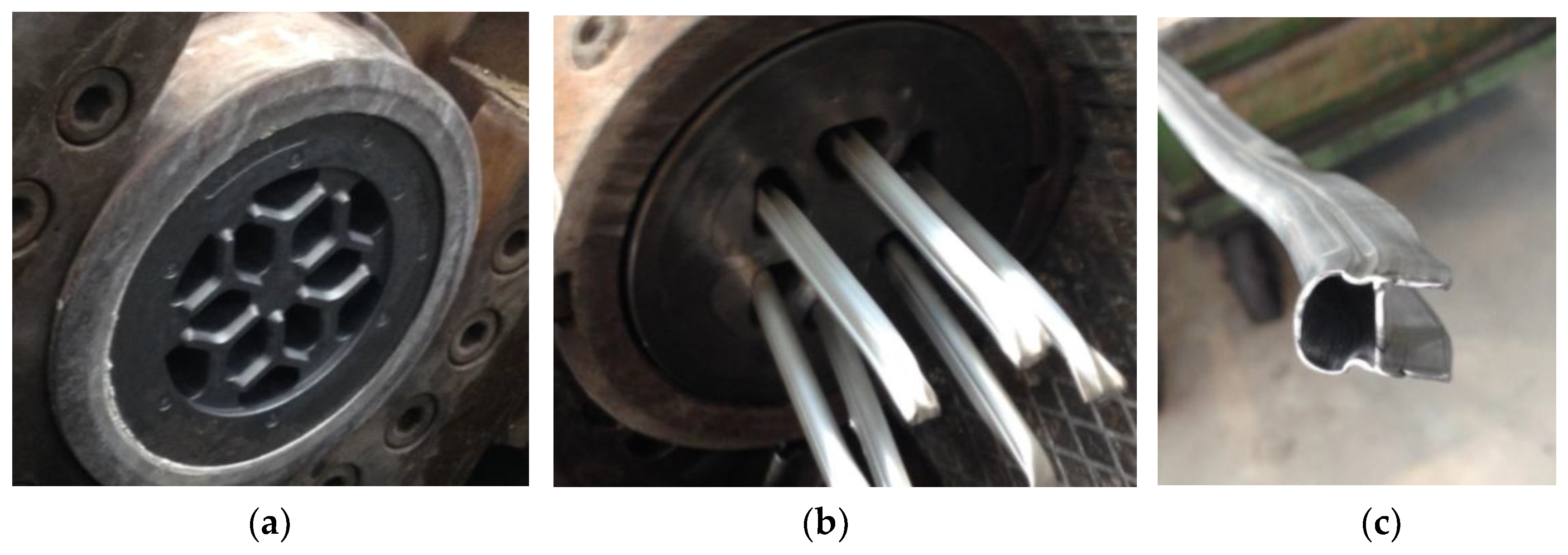
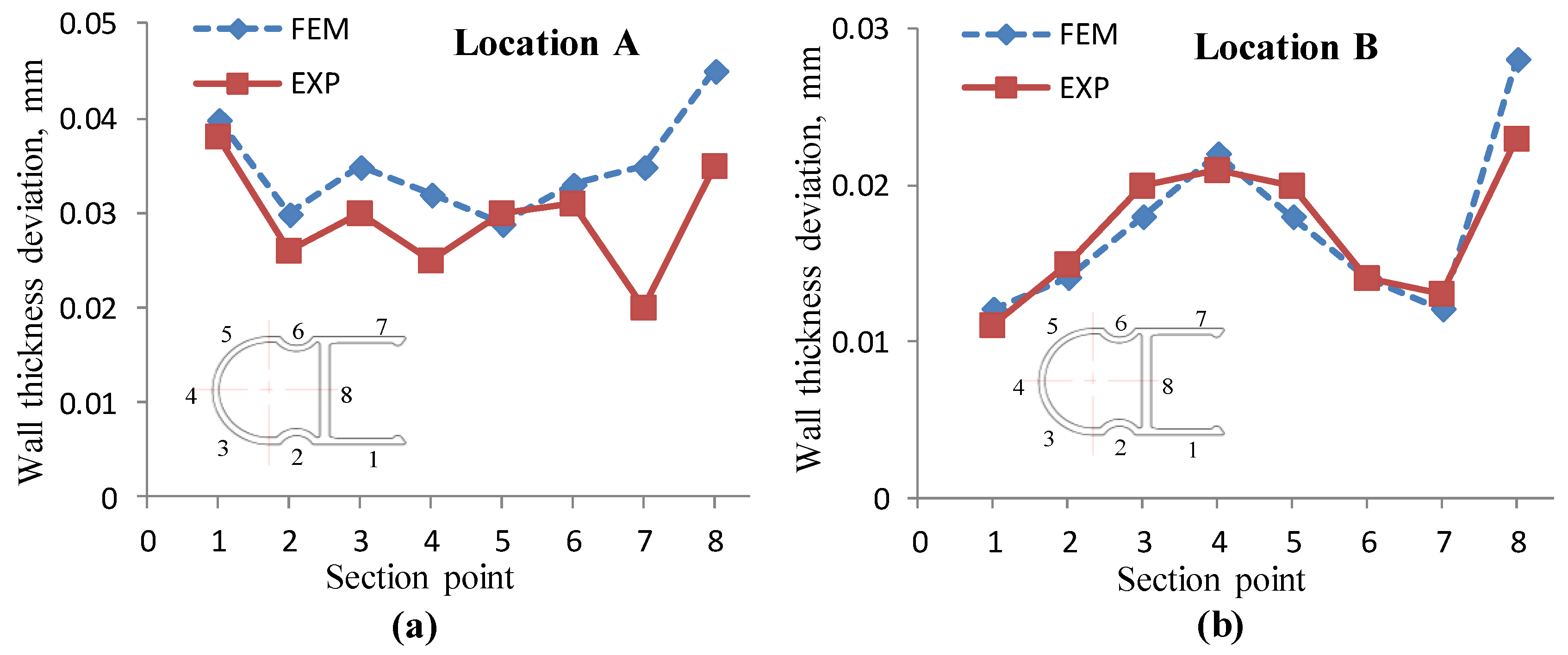
| Control Factors | Levels | |||
|---|---|---|---|---|
| 1 | 2 | 3 | ||
| A | Billet buckle angle (α, °) | 5 | 15 | 30 |
| B | Porthole bevel angle (β, °) | 5 | 7.5 | 10 |
| C | Depth of welding chamber (d, mm) | 10 | 15 | 20 |
| D | Bridge type | Brale | Trapezium | Round |
| Material | Q, J/mol | R, J/(mol·K) | A, s−1 | n | β, m2/N |
| AA6060 | 1.44 × 105 | 8.314 | 5.91 × 109 | 3.515 | 3.46 × 10−8 |
| Material | E, GPa | λ, N/(s·C) | ρ, kg/m3 | υ | δ, N/(mm2·C) |
| H13 | 210 | 24.3 | 7870 | 0.3 | 460 |
| No. | Process Parameters | Values |
|---|---|---|
| 1 | Billet diameter, mm | 180 |
| 2 | Billet length, mm | 400 |
| 3 | Extrusion ratio | 96.7 |
| 4 | Ram speed, mm/s | 5.0 |
| 5 | Billet preheat, °C | 480 |
| 6 | Container initial temperature, °C | 430 |
| 7 | Heat convection coefficient, W/m2·C | 3000 |
| 8 | Work converted to heat, % | 90 |
| 9 | Quantity of output | 6 |
| Displacement Magnitude | MMD-A (mm) | MMD-B (mm) |
|---|---|---|
| X-displacement (max.) | 0.0703 | 0.0859 |
| Y-displacement (max.) | 0.0695 | 0 |
| XY-displacement (max.) | 0.0989 | 0.0859 |
| No. | α (°) | β (°) | d (mm) | Bridge Type | MMD-A (mm) | SDV-A (mm/s) |
|---|---|---|---|---|---|---|
| 1 | 5 | 5 | 10 | Brale | 0.0989 | 10.256 |
| 2 | 15 | 7.5 | 15 | Trapezium | 0.0912 | 9.876 |
| 3 | 30 | 10 | 20 | Round | 0.0993 | 9.514 |
| 4 | 5 | 5 | 10 | Round | 0.0970 | 10.058 |
| 5 | 15 | 7.5 | 15 | Brale | 0.0905 | 9.879 |
| 6 | 30 | 10 | 20 | Trapezium | 0.1042 | 9.543 |
| 7 | 5 | 5 | 10 | Trapezium | 0.0992 | 10.119 |
| 8 | 15 | 7.5 | 15 | Round | 0.0918 | 9.894 |
| 9 | 30 | 10 | 20 | Brale | 0.1003 | 9.486 |
© 2018 by the authors. Licensee MDPI, Basel, Switzerland. This article is an open access article distributed under the terms and conditions of the Creative Commons Attribution (CC BY) license (http://creativecommons.org/licenses/by/4.0/).
Share and Cite
Xue, X.; Vincze, G.; Pereira, A.B.; Pan, J.; Liao, J. Assessment of Metal Flow Balance in Multi-Output Porthole Hot Extrusion of AA6060 Thin-Walled Profile. Metals 2018, 8, 462. https://doi.org/10.3390/met8060462
Xue X, Vincze G, Pereira AB, Pan J, Liao J. Assessment of Metal Flow Balance in Multi-Output Porthole Hot Extrusion of AA6060 Thin-Walled Profile. Metals. 2018; 8(6):462. https://doi.org/10.3390/met8060462
Chicago/Turabian StyleXue, Xin, Gabriela Vincze, António B. Pereira, Jianyi Pan, and Juan Liao. 2018. "Assessment of Metal Flow Balance in Multi-Output Porthole Hot Extrusion of AA6060 Thin-Walled Profile" Metals 8, no. 6: 462. https://doi.org/10.3390/met8060462






